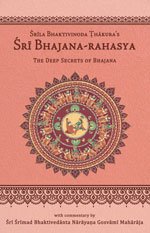Bhajana-Rahasya
by Srila Bhaktivinoda Thakura Mahasaya | 2010 | 123,965 words
The Bhajana-rahasya Text 6, English translation, including commentary (vritti). The Bhajana-rahasya is a compilation of verses describing the mercy of the eight pairs of names (Yugala-nama) of the Maha-mantra. This is text 6 belonging to the chapter “Saptama-yama-sadhana (Pradosha-kaliya-bhajana–vipralambha-prema)” representing from six dandas of the night until midnight: approximately 8.30 p.m.–00.00 a.m.
Text 6
Upon hearing the sound of Kṛṣṇa’s flute, moving living entities acquire the nature of the non-moving, and non-moving entities acquire the nature of the moving. Śrīmad-Bhāgavatam (10.21.19) states:
गा गोपकैर् अनु-वनं नयतोर् उदारवेणु-स्वनैः कल-पदैस् तनु-भृत्सु सख्यः
अस्पन्दनं गति-मतां पुलकस् तरूणां निर्योग-पाश-कृत-लक्षणयोर् विचित्रम्gā gopakair anu-vanaṃ nayator udāraveṇu-svanaiḥ kala-padais tanu-bhṛtsu sakhyaḥ
aspandanaṃ gati-matāṃ pulakas tarūṇāṃ niryoga-pāśa-kṛta-lakṣaṇayor vicitramO sakhīs, the elegance and charm of the two brothers, our Śyāmasundara and Gaurasundara Balarāma, are quite unique and wonderful. When Śyāmasundara, together with His cowherd friends, leads the cows from one forest to another by sweetly playing a melody on His veṇu, He binds the top of His turban with the niryoga rope, which is used for binding the legs of calves, and from His shoulders (like His pītāmbara ) hangs a rope known as pāśa. Upon seeing that sweet, unparalleled beauty and hearing the sound of the veṇu, moving living entities, such as animals and birds, as well as rivers–and what to speak of human beings–become inert like stone. And ecstatic symptoms like horripilation are displayed in non-moving entities, such as trees. Sakhī, how can I describe the magical sound of that flute?
सखा-धेनु-सङ्गे कृष्ण उदार-स्वभाव
मुरलीर गाने सबे देय सख्य-भावsakhā-dhenu-saṅge kṛṣṇa udāra-svabhāva
muralīra gāne sabe deya sakhya-bhāvaजङ्गमे करिल स्पन्द-हीन, तरु-गणे
पुलकित कैल अहो! विचित्र लक्षणेjaṅgame karila spanda-hīna, taru-gaṇe
pulakita kaila aho! vicitra lakṣaṇeहेन कृष्ण ना पाइया प्राण फेटे याय
कबे सखि! विधि कृष्ण दिबेन आमायhena kṛṣṇa nā pāiyā prāṇa pheṭe yāya
kabe sakhi! vidhi kṛṣṇa dibena āmāya
Commentary: Bhajana-rahasya-vṛtti:
The beautiful women of Vraja, being filled with mahābhāva, ref lect, “All the moving and non-moving entities of Vṛndāvana are blessed. Their lives are successful because, regardless of their form, they have attained the touch of Kṛṣṇa’s lotus feet, or else they have attained some kind of relationship with Him. In the whole of Vraja, only we are unfortunate.” As the vraja-ramaṇīs speak, the pastime of Kṛṣṇa taking the cows to graze in the forest and the melodious sound of His veṇu manifest in their hearts. Now they become completely immersed in ecstatic rapture, as if seeing Kṛṣṇa directly.
Overwhelmed with prema, they say, “Look sakhī ! How sweet are the movements of Śyāmasundara, the best of dancers, as He gracefully roams from one forest to another. The sweet sound of His flute causes all moving and non-moving living entities to become overwhelmed with the ecstasy of prema, and they visibly manifest aṣṭa-sāttvika transformations.”
Furthermore, the gopīs say, niryoga-pāśa-kṛta-lakṣaṇayor vicitram. “Aho ! What a beautiful sight are the two brothers, Rāma and Kṛṣṇa, as They walk into the forest wearing the niryoga and pāśa on Their bodies.” While the cows are being milked, with a rope their restless calves are tied before them to a post in the ground. In this way, their mothers can see them. This rope is called niryoga. Another rope, pāśa, binds the two hind legs of a restless cow to keep her calm while being milked. The niryoga and pāśa used by Śrī Kṛṣṇa are made of soft, yellow threads of jute, tied at either end with clusters of pearls. Like the other gopas, Kṛṣṇa ties the niryoga to the top of His turban and lets the pāśa hang from His shoulders on to His chest. His attire is so fascinating that anyone who sees it cannot help being charmed, and the mere sight of it renders the prema-filled goparamaṇīs unconscious.
They continue, “O sakhī, in Vidhātā’s creation there is no living entity who will not be charmed by the sight of the sweetness of Rāma’s and Kṛṣṇa’s beauty, which attracts the entire universe. When Kṛṣṇa plays a melody on His enchanting muralī to gather together the cows who are far away, the condition He creates is difficult to describe. When the tinkling of the ankle bells on Kṛṣṇa’s lotus feet mixes with the inexpressibly melodious sound of His captivating muralī, the sweetness of that sound increases even more. Is there any person who can remain composed upon hearing this?”
While discussing Kṛṣṇa’s enchanting cowherd attire and the sound of His flute, the vraja-ramaṇīs, who are helplessly immersed in prema, say, “Sakhī, upon seeing Kṛṣṇa’s niryoga and pāśa, it seems that they really are niryoga-pāśa–through them, yoga (meeting) is certain to take place uninterruptedly, for one’s whole life. Even continuous samādhi-yoga is insignificant compared to this. Kṛṣṇa’s niryoga-pāśa are really prema-pāśa, ropes of love. The Vrajavāsīs and the vana-vāsīs (forest entities) are rendered helpless by His niryoga-pāśa. This demonstrates the amazing effect of these ‘ropes of love’.” In this way, the gopīs consider Śrī Kṛṣṇa’s niryoga-pāśa to be a trap of love.
Hearing the sound of Kṛṣṇa’s flute, all the deer, birds and other forest creatures are overwhelmed by prema and become inert. The trees, creepers and other non-moving living entities give up their natures and adopt the characteristics of moving beings. They become jubilant and experience ecstatic symptoms. Furthermore, the Yamunā, Mānasī-gaṅgā and other rivers stop flowing, and the stones on Govardhana and other mountains melt and f low like streams.
